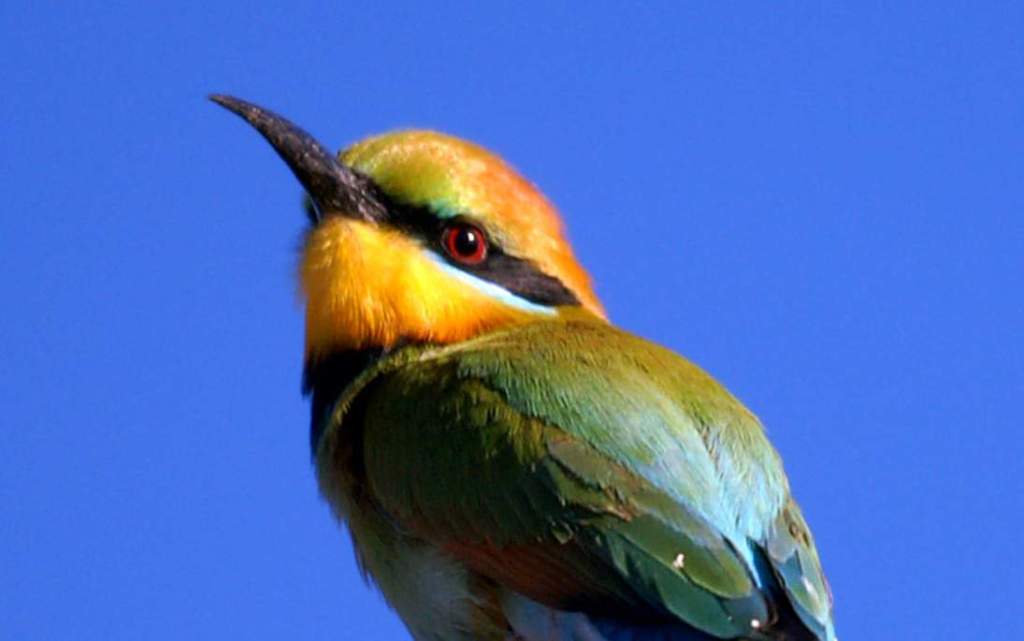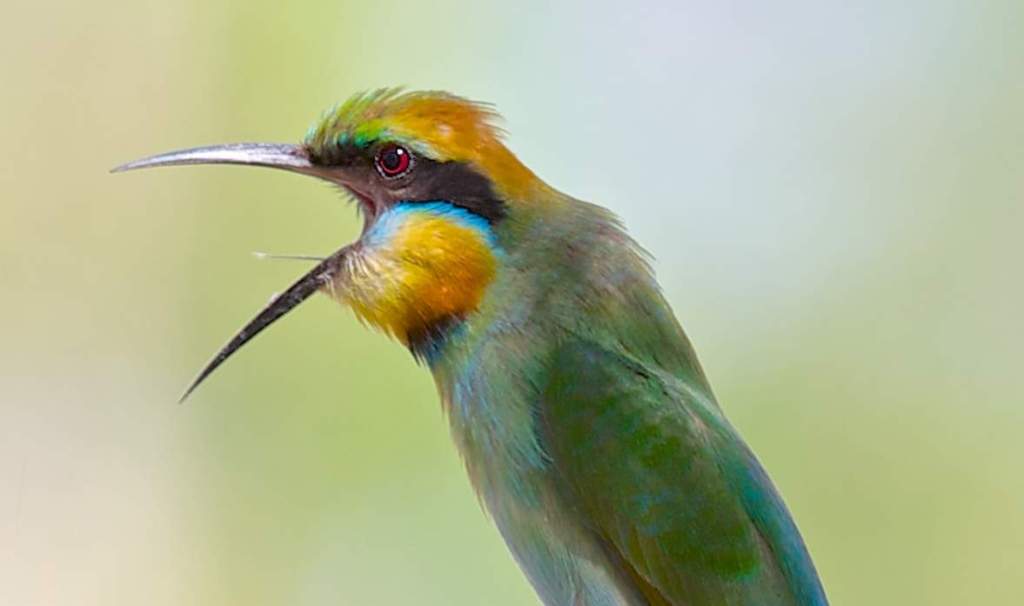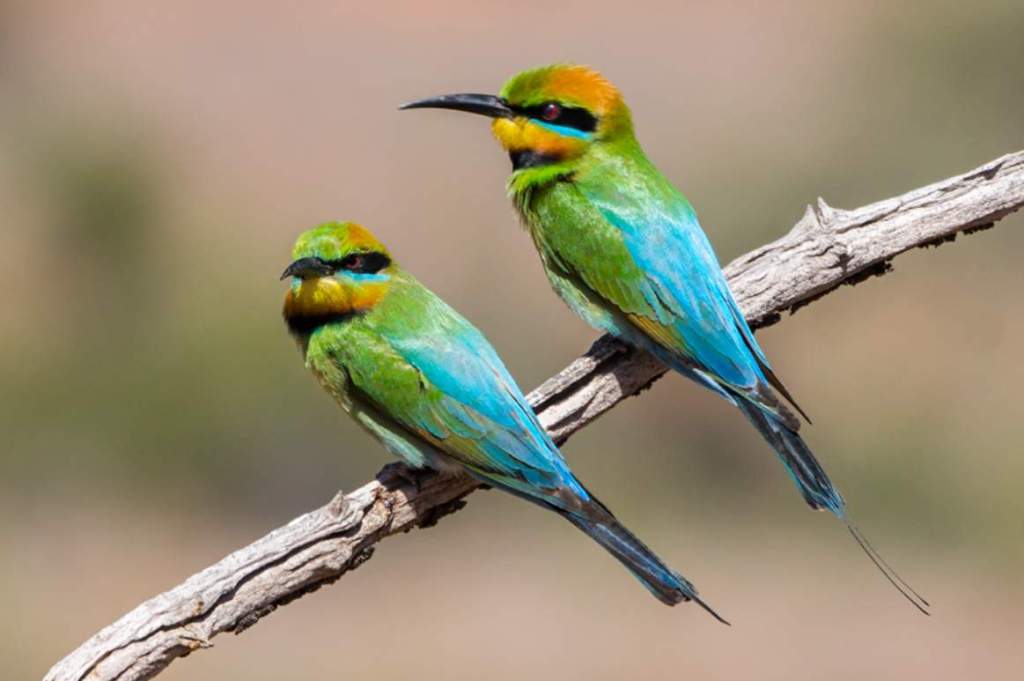Habitat: The Rainbow Bee-eater is a communal bird, whether residing on breeding grounds in southern and central Australia, in winter quarters in far northern Australia and islands beyond, or on migration between them.
During migration, birds travel in loose groups of 15 to 30 birds, calling constantly to one another and traveling by night and day. They also roost together at night, often in small shrubby trees. A bee-eater’s perch is as immobile as its flight, its weak, partly fused toes allowing it to grasp branches and sit only.
Breeding is a time when social interaction is at its peak. The Rainbow Bee-eaters spend their days perched out on bare, exposed horizontal branches or less often on the ground, making convoluted aerial sallies to catch insects. Their wide, pointed wings make them excellent fliers, allowing them to flutter, glide, twist, wheel, and swoop effortlessly. The rainbow bee-eater is very social, like all bee-eaters.

Food: Most of their food is captured on the wings, mainly venomous Hyme noptera – wasps and bees – and dragonflies, damsel fly, beetles, and other small flying insects. Before eating, the bee-eaters batter and squeeze out any stings from their prey before flying back to a perch. In an average day, several hundred wasps and bees are taken and thrown into pellets that are indigestible.
Nest & Breed: Often, Rainbow Bee-eaters nest in communes of 30 to 40 birds. As well as digging burrows, they also help one another incubate, brood, and feed their young; up to eight birds have been seen assisting at one nest. Males, usually young and unmated, provide much assistance, outnumbering females by three to two.
With their feet, they scrape out burrows quickly after digging them with their bill. Feeding and nesting occur between November and January in the south and between September and May in the north. It is a tunnel dug in sand banks or into flat ground, with a circumference just larger than the bird’s body. It leads to a wide unlined egg chamber 250 mm from the end.

Identification: There is little difference between the sexes except that the female has a lighter tail and a shorter, thicker tail than the male. The crown is golden green, grading to light rufous at the nape. The back and wing coverts are golden-green, and the rump is sky-blue. Black tips on innermost secondaries; underwing rufous-buff.
Flight feathers russet-green tipped with black. There is a broad black stripe through the eye, outlined in turquoise blue above and below. There is a thick black bar covering the lower edge of the chin, with or without a blue wash below.
The chin is mid-yellow, gradually fading to rufous yellow at the upper throat. Its breast is golden-green, grading to pale blue-green on its belly; the crissum is sky blue. A bluish-black tail is duller below. Its eyes are crimson. Black is the color of the bill. Black claws and dark grey feet.
The immature bird’s head and back are dull greyish green, and the throat is buff-yellow without a black band; the breast, belly, and vent are grey-green; the tail is not extended. There is a brown color to the eyes. A young bird may not be able to breed until the second year after it has gained adult plumage without tail streamers.
Vocalizations: Mostly in flight, Rainbow Bee-eaters chirrup with a constant high-pitched trrrrp, trrrp, which is probably a contact call.
Eggs: Rainbow Bee-eater lays three to seven eggs, usually four or five, every second day. Eggs are glossy, translucent white, about 24 x 18 mm, and rounded. Incubation lasts about 22-25 days, by a parental pair and helpers; begins with the first egg. After hatching, the young are naked and pinned feathers come in about a week after hatching; they are brooded and fed by parents and helpers.
Distribution: A breeding migrant throughout drier Australian woodlands, the Rainbow Bee-eater is mostly found north to south; it breeds south of the Kimberleys and Gulf of Carpentaria in spring, and migrates north to winter across northern Australia (Arnhem Land, Cape York Peninsula) in March-April, often reaching Lesser Sundas, New Guinea and Bismarck Archipelago. Several species of birds breed in autumn after the wet season in mid-far northern Australia, at least some of which are present year-round.
Similar species: Currently, rainbow bee-eaters are the only monotypic species of Meropidae in Australia. Most likely, its closest relative is the olive bee-eater (Merops superciliosus) of southern and eastern Africa. According to molecular phylogenetic analysis, the rainbow bee-eater is the closest relative of the European bee-eater (M. apiaster).
Alternative names: This small bird is also known as the Australian Bee-eater or Rainbow-bird.
Size: Rainbow Bee-eaters are about 210-240 mm long, including two central tail feathers, which extend 20-40 mm beyond the rest of the tail and weigh between 20 and 32 grams.
Status: Least concern
Races: No races.
Domain: Eukaryota
Family: Meropidae
Kingdom: Animalia
Class: Aves
Genus: Merops
Order: Coraciiformes
Species: M. ornatus
Phylum: Chordata
Read More – The Brightly and Colorful Bee-eaters







